Shooting
| |
Building the perfect arc in your shot
From Michael Austin Senior Editor Winning Hoops Magazine
 Building the perfect arc in your shot | Winning Hoops
Building the perfect arc in your shot | Winning Hoops
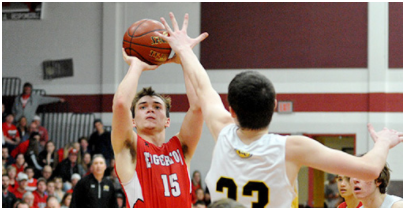 Next time all of your players are in the gym, watch them as they shoot around. Don’t look at their mechanics, but rather look at the arc of their shot. Is the shot flat? Or does it seem to touch the clouds in an effort to bring rain down from the sky? Also, do your shooters have a consistent arc or are they just firing the ball at the rim at all angles?
Next time all of your players are in the gym, watch them as they shoot around. Don’t look at their mechanics, but rather look at the arc of their shot. Is the shot flat? Or does it seem to touch the clouds in an effort to bring rain down from the sky? Also, do your shooters have a consistent arc or are they just firing the ball at the rim at all angles?
For years, coaches have been trying to get their players to shoot with proper mechanics. But in reality, to turn a good shooter into a great shooter (or a mediocre one into a good one) an athlete must master the art of arc.
How do we know this? Experienced researchers at have been conducting studies for more than a decade to find the perfect angle and depth (into the rim) a shot should travel to score the most. Alan Marty, the founder of Noah Basketball, was the first to take on this challenge when he watched the best shooters in the world. Marty found that these shooters consistently appeared to have the same medium-height arc on their shots and shoot deep in the basket. But yet, most players haven’t figured this out, as statistics show that free-throw percentages at the NBA and NCAA level have not improved since 1958 (a steady 74% and 68% respectively).
“There are thousands of coaches and shooting gurus who believe they know the answer to great shooting,” says Marty. “Then why, with so many experts available, has foul-shooting percentage remained constant in the NBA and NCAA?”
Identifying the problem
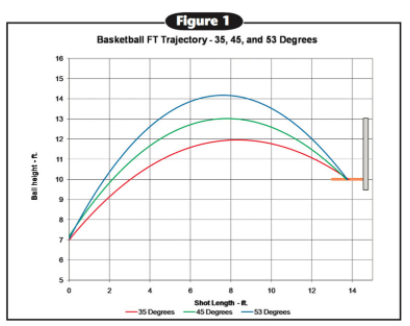
Figure 1
To reach a conclusion, Marty worked with the likes of Jerry Krause, the National Association of Basketball Coaches research chairman (who also currently served as Gonzaga University’s director of basketball operations); John Carter, now the CEO of Noah Basketball; and Dr. Tom Edwards, a NASA scientist. This team has spent years figuring out a substantive physics- and neuroscience-based method for players to make more shots.
Their conclusion is that an average shooter who shoots with an optimal arc of 45 degrees (give or take two degrees) is going to make about 11% more free throws than a shooter with a high arc of 53 degrees (68% vs. 57%). The same holds true going the other way. That same average 45-degree shooter makes 12% more free throws than a flat-arc 35-degree shooter (68% vs. 56%). FIGURE 1 shows what a 35- (red line), 45- (green line) and 53-degree (blue line) arc look like.
For very skilled shooters, the same conclusion is found. A very skilled 45-degree-arc shooter averages a make-rate of 96%, while the 53-degree high arc shooter makes 89% and a 35-degree flat-arc shooter makes 80% of his or her free throws. Clearly, very skilled shooters make many baskets, but they could be making even more shots which is why this research is so critical.
“Sadly, most of the technology and shooting aids in basketball have been validated only by testimonials or someone’s opinion,” said Krause. “This is not the best validation of what works.”
“We are the first group to systematically and scientifically confirm what makes great shooters great,” Marty said.
In addition to the solid shooting mechanics taught by shooting coaches, players must also master these three shooting principles, according to Marty:
- All great shooters shoot the ball straight.
- All great shooters shoot the correct distance (11 inches beyond the front of the rim).
- And all great shooters shoot a consistent, medium height arc of 45 degrees.
Why 45 degrees?
Carter says he took a three-pronged approach to learning and testing the ideal shooting arc for basketball players, which consisted of the following:
1. What are the best shooters in the world shooting? Carter says the research team found out that some of the best shooters, including former NBA All-Stars Chris Mullin and Mark Price, consistently had their shot entry angle in the mid-40-degree range. To arrive at this conclusion, the company measured well over 10,000 shooters of all different ages and skill levels.
2. What did Dr. Tom Edwards find? Edwards is the director for aerospace at the NASA Ames Research Center. He earned his B.S.E. in Mechanical and Aerospace Engineering at Princeton University and holds a Ph.D. and M.S.E. degrees in Aeronautics and Astronautics from Stanford University. Edwards used a detailed mathematical model and determined that the best shooters would have an arc in the mid-40s.
3. What did the automated shooter find? The research team wanted to test Dr. Edwards’ computer models by shooting real basketballs at real hoops. They built an automated shooting machine that had a programmable shot height and skill level. The researchers programmed the machine to take 250 free throws at a 35-, 40-, 45-, 50- and 55-degree shot-entry level. The angle that made the most shots? You guessed it — 45 degrees.
Not just arc alone — distance too
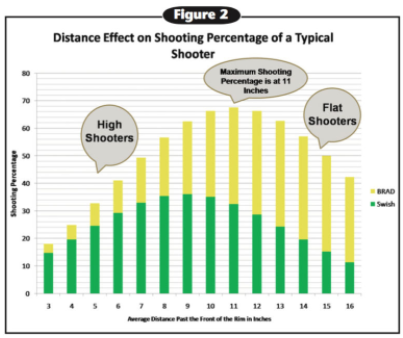 While researchers discovered the perfect arc for shooting, they also wanted to determine the best depth in the rim for making the most shots. Coaches always seem to be stressing to “swish everything,” but is that really the best way to instruct players? Carter emphatically says “no.”
While researchers discovered the perfect arc for shooting, they also wanted to determine the best depth in the rim for making the most shots. Coaches always seem to be stressing to “swish everything,” but is that really the best way to instruct players? Carter emphatically says “no.”
“Many players today simply do not shoot the ball deep enough in the basket,” Carter explains. “You don’t get an extra point for a swish. The research clearly finds that players who shoot the ball deeper in the basket make more shots. Watch some of the best shooters, and you’ll see they don’t always swish the ball. Instead, they often hit the back of the rim and score a BRAD shot, which stands for ‘Back Rim And Down.'”
Carter says specifically the spot where a player makes the most shots is when they average shooting 11 inches past the front of the rim. The diameter of a standard rim is 18 inches, so getting the ball two inches past the middle is ideal for shooters.
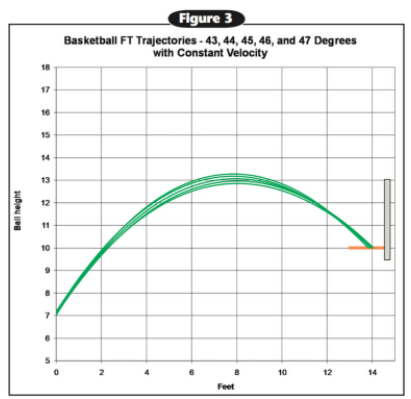
Figure 3
To get the ball two inches past the middle of the rim, shooters need to focus on their arc. Carter says high-arcing shooters generally are short when they miss, while line-drive shooters skew toward being too long on their shots (FIGURE 2).
Consistency is key
As with most things in the game of basketball, consistency is a major key in making shots. “An inconsistent shooter is never going to be great even if he or she averages a 45-degree arc and 11 inches in depth,” explains Carter.
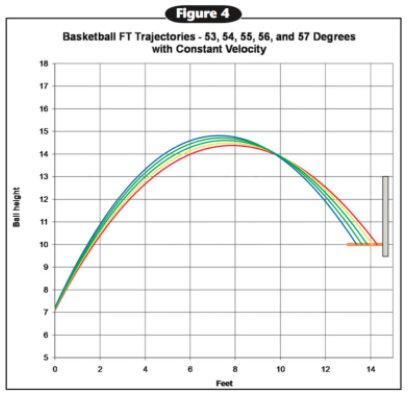
Figure 4
An inconsistent shooter might average 45 degrees, but to do so that player ends up firing up a large number of high 55-degree shots as well as low 35-degree shots.
An inconsistent shooter also might average 11 inches of depth in a shot but, again, that only comes from shooting the ball well short and very long to come to the average.
“A great shooter only varies plus or minus two degrees on shot arc. If the shooter puts the same power behind the shot ,and it’s consistently in the mid-40-degree range, the ball is going to go the same distance,” says Carter. See FIGURES 3, 4, 5 and 6.
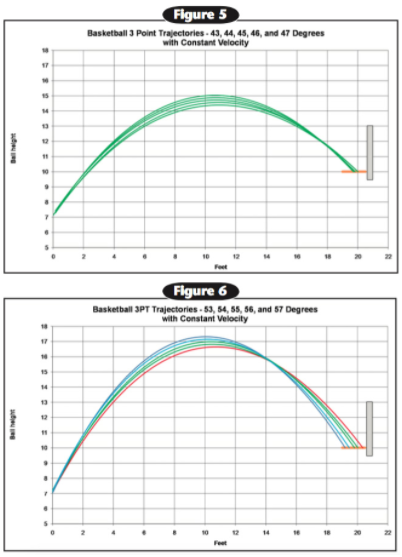
Figures 5-6
Chris Mullin shot 25 three-pointers for Noah Basketball research. He made 24 of those shots and his average angle of entry was 44.5 with a low of 43 and a high of 46. This is the kind of consistency that builds an NBA career in which he made more shots than he missed (Mullin had a field-goal percentage of 50.9% during his 16-year career) and knocked down 86.5% of his free throws.
